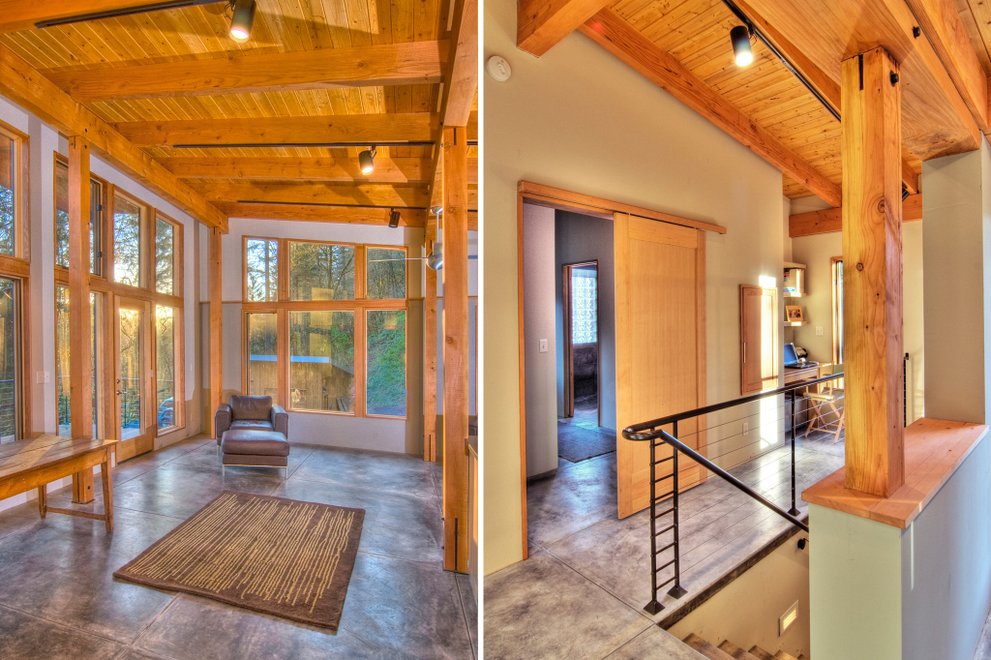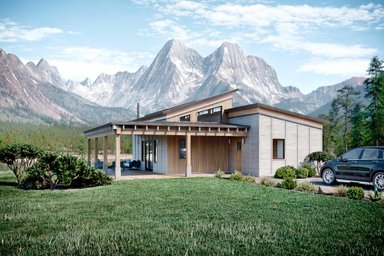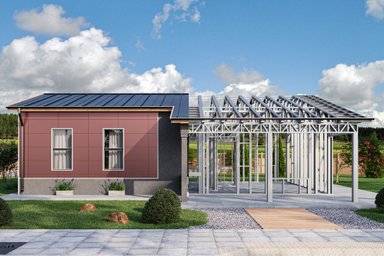Our ancestors, building homes before the days of mechanical
heating and air conditioning, understood almost intuitively how to harness the
natural forces of sunlight and wind. Thankfully, many of these techniques have
made a strong comeback in recent years as people try to maximize the
satisfaction of their home environment. The sun and the wind, whether you
realize it or not, influence the rooms you like best, how well you see inside,
your electric bill, and your overall well-being. Here’s where to start thinking
about the “chi” of your next house.
The biggest variable is the solar orientation of your lot. The ideal situation is when your home is situated along an east-west street. That way the biggest portion of the roof faces south or north. That not only enables you to do more with photovoltaic panels (they are more efficient facing south) but it opens up daylight opportunities that can dramatically influence the enjoyment of your home. The optimal situation is when the back of your house faces south, since you can hide the solar panels from the street. Don’t worry, though, if your home will be oriented differently; all is not lost.
The other reason this orientation is preferable is because most new homes these days relegate the most commonly used rooms – the family room and kitchen – to the back of the house. You can use windows in the back (or south side) of the house to soak up heat during the winter months when the sun is low in the sky. Then you can use a porch, an overhang, or even a trellis to shade the home during the summer, when the sun is high in the sky. A study by the Bonneville Power Administration found that re-orienting homes toward the sun saved between 10 and 20 percent on heating costs – without any additional solar features. Plan 935-14, below, features overhangs that shade the home and add Prairie-style flair.

How the sun strikes your home may influence your choice of a bedroom location as well. If you want to rise with the sun, then put your bedroom on the east side. If you prefer to sleep in, you may prefer your bedroom on the west or north side. Plan 890-6 provides plenty of windows to the bedrooms, so you can wake with the sun if you like.

If noisy traffic is a consideration, you may want your bedroom as far from that nuisance as possible. It’s usually no problem, though it may involve a cost, for a designer to redraw a plan to put the master bedroom on the side you prefer. Many plans are sold with pre-drawn reversals, like plan 895-60 below.

Some other rules of thumb apply. The east side of your home, since it gets the most morning sunlight, may be the ideal spot for a kitchen nook to do morning crossword puzzles or a Zen garden to meditate. The office in plan 924-1 would make an excellent east-facing spot to get productive work done in the morning.

The east side is a good place to put a dense floor -- concrete or tile -- that will soak up early morning sun and radiate heat into the rest of the house during the day. That’s how early adobe homes were heated. And many fancy New England cottages still employ the technique today.
The west side of the house, on the other hand, often gets the most sun. That makes it a bad location for a TV room, since sunlight may produce glare that makes it hard to view the screen. But it may be a great location for a hot tub to enjoy the sunset, especially in a northern climate where heat from the sun is precious. Most architects, when designing from scratch, put seldom used rooms on the west side – the laundry room, closets, bathrooms, the garage. If you have an option, you may also want to locate the garage on west-facing portion of your lot, unless you plan to spend a lot of time there.
Most designers try to limit fenestration on the north side of the home. These windows produce the least natural light. Unless they are high efficiency windows, they may even be a source of heat loss.
Wind is another important natural force worth controlling. Winds typically come from the southwest during the summer and northwest during the winter. But they can vary -- you may want to make trips to your lot to check. One reason this is important is that insects don’t like wind. If you are planning a deck or open porch, put it where it gets the most breezes. Another tactic is to use trees, or a detached garage, to funnel prevailing wind toward the porch.
Prevailing winds should also influence where you put windows. You can take advantage of natural ventilation and save on air conditioning bills by creating a wind tunnel through the house. You want wind coming in a window and going out on the opposite one with minimal interruption. Ceiling fans can help facilitate the process. Planting trees, shrubs, and flowers outside the window may cool the air before it enters the house. That’s definitely a better situation than drawing air from a hot driveway slab.
Some plans do a better job than others creating a natural cooling effect. You want cool air to enter the house from a low window and leave through high windows – designers often put them in the stairway. You can increase wind velocity by using smaller windows for air to enter and bigger windows for air to exit. Certain features – like long meandering hallways or rooms with odd angles – may work against a free flow of air through the house. Transoms over doors can move air from one room to the next.
One secret to creating the most enjoyable rooms is to give them windows on two or more sides. That not only increases the opportunity for natural ventilation, but it helps control glare, which is often worse when sunlight has only one opportunity to enter a room. Another common daylight tactic is to use surfaces by the window to bounce light into the interior. That may provide enough natural light that you don’t have to use an electric light. Plan 132-221 puts windows on two sides of the master suite.

One advantage to open floor plans is that they allow spaces to borrow light from each other. If you know you will have a room that won’t get a lot of natural light, consider a skylight or a solar tube. Plan 929-1032, below, places a sun tunnel in the laundry room to add light.

A stairwell at the center of the home may be the ideal location. It could light otherwise dark spaces. Plan 64-260 shows how bright and cheerful a staircase can be when naturally illuminated.

Don’t worry if you can’t employ all these old-school techniques on your new home. Even doing a few of them will result in a more enjoyable and satisfying home, a home with more chi. And remember that most house plans can be revised for a small fee. Go over your favorite plans with an idea of how the sun and wind will affect it. It can be a fun, and spiritually rewarding exercise.
Interested in energy-efficient designs? Check out our collection here.
The biggest variable is the solar orientation of your lot. The ideal situation is when your home is situated along an east-west street. That way the biggest portion of the roof faces south or north. That not only enables you to do more with photovoltaic panels (they are more efficient facing south) but it opens up daylight opportunities that can dramatically influence the enjoyment of your home. The optimal situation is when the back of your house faces south, since you can hide the solar panels from the street. Don’t worry, though, if your home will be oriented differently; all is not lost.
The other reason this orientation is preferable is because most new homes these days relegate the most commonly used rooms – the family room and kitchen – to the back of the house. You can use windows in the back (or south side) of the house to soak up heat during the winter months when the sun is low in the sky. Then you can use a porch, an overhang, or even a trellis to shade the home during the summer, when the sun is high in the sky. A study by the Bonneville Power Administration found that re-orienting homes toward the sun saved between 10 and 20 percent on heating costs – without any additional solar features. Plan 935-14, below, features overhangs that shade the home and add Prairie-style flair.

How the sun strikes your home may influence your choice of a bedroom location as well. If you want to rise with the sun, then put your bedroom on the east side. If you prefer to sleep in, you may prefer your bedroom on the west or north side. Plan 890-6 provides plenty of windows to the bedrooms, so you can wake with the sun if you like.

If noisy traffic is a consideration, you may want your bedroom as far from that nuisance as possible. It’s usually no problem, though it may involve a cost, for a designer to redraw a plan to put the master bedroom on the side you prefer. Many plans are sold with pre-drawn reversals, like plan 895-60 below.

Some other rules of thumb apply. The east side of your home, since it gets the most morning sunlight, may be the ideal spot for a kitchen nook to do morning crossword puzzles or a Zen garden to meditate. The office in plan 924-1 would make an excellent east-facing spot to get productive work done in the morning.

The east side is a good place to put a dense floor -- concrete or tile -- that will soak up early morning sun and radiate heat into the rest of the house during the day. That’s how early adobe homes were heated. And many fancy New England cottages still employ the technique today.
The west side of the house, on the other hand, often gets the most sun. That makes it a bad location for a TV room, since sunlight may produce glare that makes it hard to view the screen. But it may be a great location for a hot tub to enjoy the sunset, especially in a northern climate where heat from the sun is precious. Most architects, when designing from scratch, put seldom used rooms on the west side – the laundry room, closets, bathrooms, the garage. If you have an option, you may also want to locate the garage on west-facing portion of your lot, unless you plan to spend a lot of time there.
Most designers try to limit fenestration on the north side of the home. These windows produce the least natural light. Unless they are high efficiency windows, they may even be a source of heat loss.
Wind is another important natural force worth controlling. Winds typically come from the southwest during the summer and northwest during the winter. But they can vary -- you may want to make trips to your lot to check. One reason this is important is that insects don’t like wind. If you are planning a deck or open porch, put it where it gets the most breezes. Another tactic is to use trees, or a detached garage, to funnel prevailing wind toward the porch.
Prevailing winds should also influence where you put windows. You can take advantage of natural ventilation and save on air conditioning bills by creating a wind tunnel through the house. You want wind coming in a window and going out on the opposite one with minimal interruption. Ceiling fans can help facilitate the process. Planting trees, shrubs, and flowers outside the window may cool the air before it enters the house. That’s definitely a better situation than drawing air from a hot driveway slab.
Some plans do a better job than others creating a natural cooling effect. You want cool air to enter the house from a low window and leave through high windows – designers often put them in the stairway. You can increase wind velocity by using smaller windows for air to enter and bigger windows for air to exit. Certain features – like long meandering hallways or rooms with odd angles – may work against a free flow of air through the house. Transoms over doors can move air from one room to the next.
One secret to creating the most enjoyable rooms is to give them windows on two or more sides. That not only increases the opportunity for natural ventilation, but it helps control glare, which is often worse when sunlight has only one opportunity to enter a room. Another common daylight tactic is to use surfaces by the window to bounce light into the interior. That may provide enough natural light that you don’t have to use an electric light. Plan 132-221 puts windows on two sides of the master suite.

One advantage to open floor plans is that they allow spaces to borrow light from each other. If you know you will have a room that won’t get a lot of natural light, consider a skylight or a solar tube. Plan 929-1032, below, places a sun tunnel in the laundry room to add light.

A stairwell at the center of the home may be the ideal location. It could light otherwise dark spaces. Plan 64-260 shows how bright and cheerful a staircase can be when naturally illuminated.

Don’t worry if you can’t employ all these old-school techniques on your new home. Even doing a few of them will result in a more enjoyable and satisfying home, a home with more chi. And remember that most house plans can be revised for a small fee. Go over your favorite plans with an idea of how the sun and wind will affect it. It can be a fun, and spiritually rewarding exercise.
Interested in energy-efficient designs? Check out our collection here.






